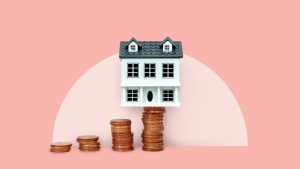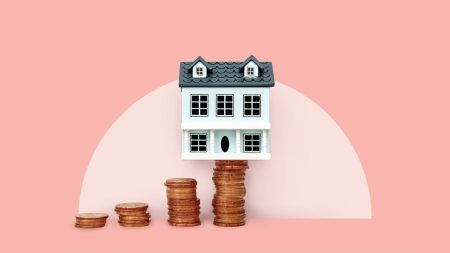Cindy Robinson/Getty Images
Mortgage rates have been on a wild ride in recent years, plunging to record lows during the pandemic, then racing up to 8 percent just a few years later. Though rates have fallen below 7 percent since, many homebuyers are still anxiously watching the Fed for any sign that they might fall further.
While the Federal Reserve more often makes headlines, there are actually many factors that influence the cost of mortgages. Here’s why rates keep changing.
How are mortgage interest rates determined?
When it comes to the mortgage rate you’re offered, your lender is generally analyzing broader market forces and deciding what it needs to charge you to make a profit.
So, what are these broader market forces, exactly? They include:
- 10-year Treasury notes: Also known as T-notes, these are securities issued by the U.S. government and considered low- to no-risk. Whenever there’s uncertainty, more investors turn their attention to safer vehicles like Treasurys, which drives yields — or the rate of return the investor can expect — down. That up-or-down movement is often tied to the interest rates on some financial products, including 30-year fixed-rate mortgages.
- Mortgage-backed securities (MBS): Another option for investors, these are bundles of thousands of mortgages, created when banks and other lenders sell the loans they make to Fannie Mae, Freddie Mac and Ginnie Mae. This process takes place within what’s known as the secondary mortgage market. Typically, when prices on MBS increase, mortgage rates decrease, and vice versa.
Both factors — the 10-year Treasury yield and MBS prices — help lenders determine how to price their loans.
“Mortgage rates typically move in lockstep with 10‑year Treasury yields. When they rise, we must adjust pricing to maintain spreads” — in other words, to make money — says Kevin Ryan, CFO of mortgage lender Better.
Similarly, “Mortgage lenders usually add a margin to the MBS rate to come up with the rate they charge for a mortgage loan,” says Preetam Purohit, head of hedging and analytics for Embrace Home Loans, based in Newport, Rhode Island.
Other market factors impacting mortgage interest rates
Overall economy
When the economy is strong — as in, when unemployment rates are low and people feel comfortable spending money on a home — mortgage interest rates are typically higher. Rates tend to fall during slower economic periods, when unemployment rates go up and buying activity slows down.
Inflation
Inflation also matters. Investors tend to demand higher bond yields in times of higher or rapid inflation because the returns they receive have less purchasing power. This impacts the yields on Treasurys, MBS, and ultimately, the rates quoted to mortgage borrowers.
Federal Reserve
The Federal Reserve doesn’t set mortgage rates, but its monetary policy decisions have some influence. When the Fed raised its key benchmark rate in 2022 and 2023, mortgage rates rose, too.
It doesn’t always play out that way. The central bank began cutting rates in 2024, but mortgage rates have moved in the opposite direction, starting off 2025 higher, in the 7-percent range.
Government policies
If the U.S. government implements policies that promote homeownership, such as a tax credit, that can stimulate demand for mortgages and possibly lead to higher rates.
Geopolitical happenings
Events abroad — like war or a major election — often impact markets in the U.S.
“A financial crisis in another country, for example, could send investors flocking to U.S. bonds as a safe haven, driving down their yields and, in turn, mortgage rates,” says Dennis Shirshikov, head of growth and engineering at vacation home platform Summer.com.
Borrower-specific factors impacting mortgage interest rates
The factors we’ve outlined so far are reflected in the mortgage rates you see advertised and reported in rate surveys. Your specific rate, though, depends both on larger mortgage rate trends and on your credit and financial circumstances. This includes:
- Credit score: A higher credit score indicates a better likelihood you’ll repay the mortgage, which translates to less risk for the lender and a lower rate for you. You can get a conventional loan with a score as low as 620, but you’ll be eligible for the best rate if your score is 740 or above.
- Down payment and loan-to-value (LTV) ratio: Your LTV ratio compares the amount you’re borrowing with the price of the home. The larger your down payment, the lower your LTV ratio and, generally, the lower your rate. If you’re making a 3 percent down payment, for example, you’d be borrowing 97 percent of the home’s price and have a 97 percent LTV ratio.
- Debt-to-income (DTI) ratio: Your DTI ratio compares your monthly debt payments — including the mortgage — with your monthly income to ensure you’re not overextended. Similar to the LTV ratio, if your DTI ratio is lower, you’ll likely get a lower rate. You can still get a conventional loan with a higher DTI ratio, but for the best rates, lenders look for no higher than 36 percent.
- Occupancy and property type: “Occupancy status, such as if this will be your primary home, secondary home or investment property, can also significantly impact the rate,” Purohit says. “If the home will be your primary residence, the rate may be lower. The type of property will also impact the rate. Any property type other than a single-family home — such as a condo, manufactured home, or multi-unit dwelling — will generally increase the mortgage rate.”
- No-closing-cost option: Some borrowers opt to finance the closing costs with the mortgage instead of paying them out of pocket upfront. In this case, the lender might charge a slightly higher rate.
- Points: A mortgage point or discount point is an optional fee a borrower can pay to lower their rate.
Lender-specific factors impacting mortgage interest rates
Mortgage rates can vary substantially from lender to lender. This is often due to differences in:
- Local competition. “An area with higher competition between lenders leads to compressed margins and lower mortgage rates,” Purohit says.
- Operational capacity and business volume. “How efficiently a lender operates — what it costs them to originate a loan, how much they pay their loan officers, and the strength of their investor network — directly impacts the flexibility they’ll have to offer competitive pricing,” says Vishal Garg, CEO of Better.
- Risk assessment. Lenders vary in the amount of risk they’re willing to absorb. Some may cater to borrowers considered higher risk and charge rates that reflect this.
Why do different mortgage types have different interest rates?
Different types of mortgages — for example, fixed-rate loans versus adjustable-rate loans or 15-year mortgages versus 30-year mortgages — also tend to charge different rates. This is generally due to the relative risk to the lender of issuing the mortgage. For example, rates on fixed-rate loans are typically higher than introductory rates on adjustable-rate loans because the fixed-rate lender takes on the risk that rates could increase during the loan’s term.
Likewise, government-backed FHA, VA and USDA loans sometimes have lower rates because they have a government guarantee or insurance that cuts the lender’s risk.
FAQ
Why we ask for feedback
Your feedback helps us improve our content and services. It takes less than a minute to
complete.
Your responses are anonymous and will only be used for improving our website.
Help us improve our content
Read the full article here












